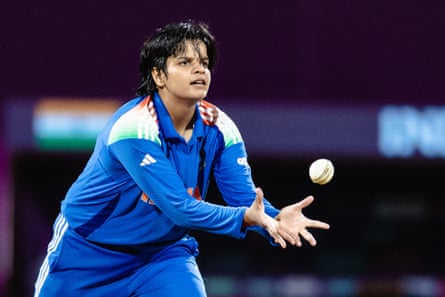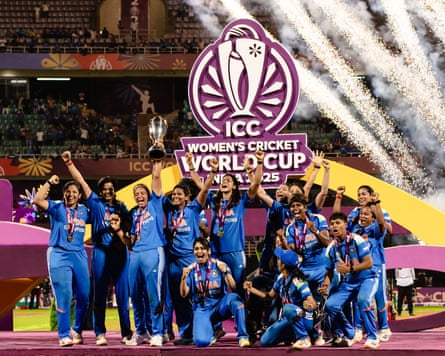Growing up in rural India, Shafali Verma always knew she had a hunger to play cricket. But in her small town of Rohtak, in the north Indian state of Haryana, cricket was not a game for girls. Aged nine, desperate to play, she cut her hair short, entered a tournament disguised as her brother, and went on to win man of the match.
Verma’s determined father, Sanjeev, in the face of refusal from every cricket academy or training centre who would not accept his daughter, enrolled her as a boy. “Luckily, nobody noticed,” he recalled, as Verma made her debut for the national women’s team at 15 years old.
On Sunday, Verma stood triumphantly with her teammates as they held aloft the Women’s Cricket World Cup, making history as the first Indian women’s national team to win the cup – and for equality. The struggles and sacrifices made for years by the women to get here – defying social stigma, a lack of resources and juggling manual jobs between training – made their win even more extraordinary.

It came at a critical turning point for women’s cricket in India, where the sport verges on a national religion, is a multibillion dollar industry but also widely regarded as a “gentleman’s game”. It was only in 2017 that female cricketers were given full-time professional contracts and a women’s premier league (WPL) established in 2023.
Varnika Choudhary, who plays for the Uttar Pradesh state under-23s women’s team, described how her small village of Beerakheri had always been very resistant to her playing cricket and it had taken two years to convince her parents to let her play. Even as the cricket-crazy village regularly gathered to watch the Indian premier league (IPL) and Men’s Cricket World Cup, women’s professional cricket was widely ignored.
But this time, said Choudhary, the whole village sat in the square to watch the Women’s World Cup final on Sunday. “Everyone in my village got so excited when they won,” she said. “They were all sending me photos and reels and messages saying: ‘This will be you winning for India one day.’”
Many in her village had been particularly impressed by Verma’s batting. “They told me, wow she’s hitting like a man,” said Choudhary. “I had to correct them and say, no she’s hitting like a woman.”
Hundreds of millions of people across India tuned in to watch the final and Choudhary was among the many who saw the win as a pivotal moment, not just for women’s cricket but for women in India more broadly, and their battle for equality in the country’s still deeply patriarchal society. Though more women in India are being educated, they endure heavy societal burdens on how they are expected to behave and present themselves in public and are uniformly lower paid across all sectors.
“More women playing cricket changes everything, not just in the sport,” Choudhary said. “We feel independent, we feel we are doing something for ourselves and that society can finally see us equal to the men.”

Sharda Ugra, one of India’s foremost cricket writers, said the significance of the match went beyond cricket. “For Indian women in the public space, your body is usually seen as a source of honour or shame,” she said. “So to see these girls – who mostly come from rural small towns – running around, sweaty, shouting, screaming and uninhibited about what they looked like, sent a very powerful message. It was quite wonderful to see.”
The national team, led by the captain, Harmanpreet Kaur, have become Indian sporting royaltyafter their win, and this week were hosted at the residence of the Indian prime minister, Narendra Modi. The significance of their triumph for women in India was widely acknowledged by the team, who paid tribute to the female cricketers who had paved the way before them. Without this trophy, said Kaur after the match, “the revolution, the change we want, won’t come”.
Ugra said she believed the win would trigger “a mass movement towards making cricket a sport that girls play for leisure, for enjoyment, as a profession”, but emphasised that women’s cricket still had a long way to go in India to catch up with the IPL, a franchise valued at about $18.5bn (£14bn).
There are only five teams in the WPL and the resources and cricket academies available for young women are still limited, especially in rural regions. Women’s cricket in India also does not have its own governing body, falling instead under the men’s.

At a cricket academy in Delhi’s Gargi college, the impact of the win was already being felt. Standing on the pitch in her cricket whites with her hands on her hips, 11-year-old Kiera Kareer said she was more motivated than ever to play for the national team one day. “This winning match proved to everybody that women’s cricket is as good as men’s, they played very smoothly,” she said. “We can hit as hard and we can run as fast. In fact, I think they played better than the men.”
A few years ago, Spreeha Maurya, now 18, was the only girl attending this academy and had spent years playing with boys. The coaches, so determined to get girls into the sport, had initially let Maurya play for free.
“It was so inspiring and motivating to watch the final, and see the stadium completely packed and everyone screaming and cheering when they won. I had never seen people react to women’s cricket like that before,” said Maurya.
“I think winning this World Cup has solidified it in our mind that women can do everything and it’s not a gentleman’s game any more.”
Standing on the sidelines, her father, Rudal Maurya, 54, said when he had first brought his daughter to state trials, there had only been about 40 girls – this year there were about 500 who attended. Looking around at the field, where girls as young as six stood in the batting nets, his eyes welled up.
“The mindset is changing, so many more parents will bring their girls for training now, and that can change the society,” he said. “My daughter is so passionate about cricket. It is the dream of our whole family that one day, she too will play for India.”
Additional reporting by Aakash Hassan

.png) 4 hours ago
6
4 hours ago
6

















































